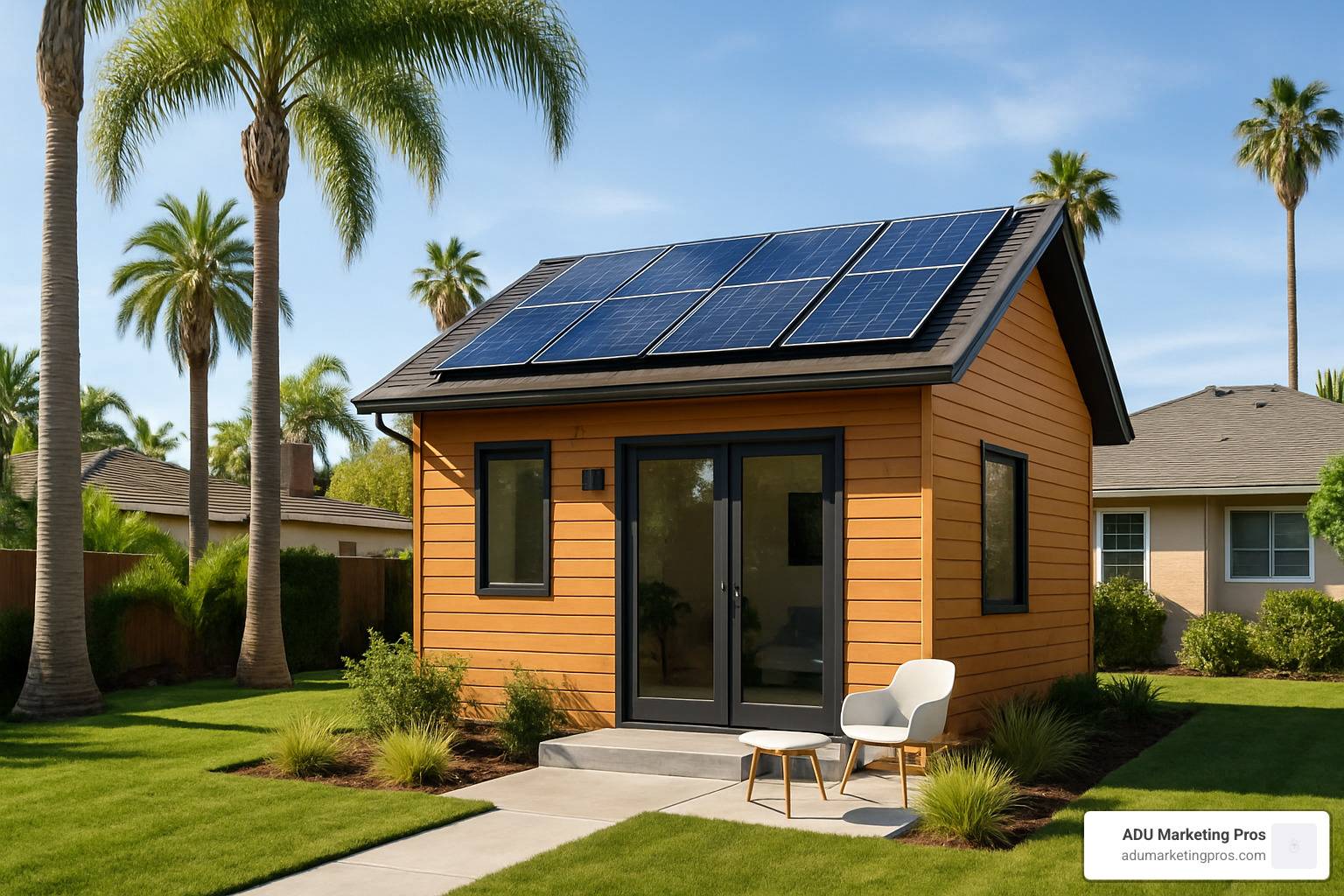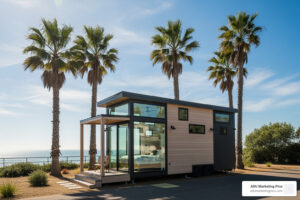Understanding California’s ADU Revolution
California ADU requirements have undergone dramatic changes in recent years, making it easier than ever to build these versatile living spaces. If you’re looking for quick answers about current requirements, here’s what you need to know:
| Key California ADU Requirement | Details |
|---|---|
| Minimum Size | 150 square feet |
| Maximum Size | Up to 1,200 sq ft or 50% of primary dwelling |
| Height Limit | 16-25 feet (varies by location and attachment) |
| Setbacks | Minimum 4 feet from side and rear property lines |
| Parking | Maximum one space per unit (with transit exemptions) |
| Processing Time | 60-day ministerial approval required |
| Impact Fees | Waived for ADUs under 750 square feet |
| Rental Terms | Minimum 30-day rentals (no short-term) |
Between 2016 and 2023, the number of ADUs permitted annually in California exploded from just 1,336 to 26,924 — a remarkable 20-fold increase. This surge isn’t accidental. California has systematically removed barriers to ADU development, recognizing these “granny flats” as a critical solution to the state’s housing crisis.
Whether you’re a homeowner looking to build a backyard cottage or a construction professional navigating the latest regulations, understanding these requirements is your first step toward success.
ADUs now make up more than 21% of all new homes permitted statewide, changing California’s housing landscape one backyard at a time.

California ADU Requirements: Definitions, Benefits & Statewide Standards
Let’s explore what actually counts as an ADU under California law—because not all backyard structures qualify!
An Accessory Dwelling Unit (ADU) is essentially a complete second home on your property, with everything someone needs to live independently. Think of it as a “home within a home” that provides full living facilities alongside your main house.
Junior Accessory Dwelling Units (JADUs) are the smaller siblings—maxing out at 500 square feet and typically carved out from within your existing home’s walls. They’re more compact but still offer independence, though they might share a bathroom with the main house.
As Erin Rank from Habitat LA recently pointed out at an ADU dedication: “Half of Los Angeles is single-family homes… We see ADUs as a way to use existing land to create more affordable housing for everybody.”
What Qualifies as an ADU Under California ADU Requirements
Under California ADU requirements, your secondary unit can take several forms:
You might build a detached ADU—a completely separate structure in your backyard, like a cottage or tiny home. Or perhaps an attached ADU makes more sense, sharing at least one wall with your main house while maintaining privacy and separate entry.
Many homeowners opt for conversion ADUs, changing existing spaces like garages, basements, or attics into living quarters. And don’t forget about Junior ADUs (JADUs), which nestle within your main home’s existing walls but can’t exceed 500 square feet.
For any space to legally qualify as an ADU, it needs a few essentials: a proper kitchen with sink, cooking appliance and refrigeration; at least a three-quarter bathroom (toilet, sink, and shower); its own entrance; and a minimum of 150 square feet of living space. The California Department of Housing and Community Development (HCD) explains it simply: “An accessory dwelling unit is a separate living area on a property with a proposed or existing primary residence.”
Benefits of Building an ADU in California
Adding an ADU to your property isn’t just about following a trend—it can transform your lifestyle and finances in meaningful ways.
From a money perspective, the benefits are clear. Many California homeowners generate between $2,000-$3,500 monthly in rental income from their ADUs. Your property value typically jumps by up to 30% after adding a well-designed ADU. Plus, there are potential tax advantages if you rent the unit, and most homeowners see their investment pay off within 5-10 years.
But the lifestyle benefits often matter even more. ADUs create perfect multigenerational living solutions where everyone maintains independence with proximity. Your aging parents can live nearby but separately, adult children can save for their own homes while having privacy, and you can work from home in a dedicated space away from household distractions.
One San Jose homeowner told us: “My ADU pays for itself through rental income, and I’ve been able to help my elderly mother maintain her independence while keeping her close. It’s been a win-win for our family.”
Communities benefit too—ADUs add housing without requiring new infrastructure, reduce commute times by creating homes in established neighborhoods, and make efficient use of existing land in areas with good jobs but housing shortages.
Statewide Size, Height & Setback Rules for California ADU Requirements
California has established consistent rules that apply regardless of where you live in the state, though local jurisdictions may have additional requirements.
For sizing, ADUs must be at least 150 square feet (about the size of a small bedroom). Detached ADUs can go up to 1,200 square feet or 50% of your primary home’s size, whichever is smaller. Attached ADUs max out at 50% of your main home’s square footage. Junior ADUs must stay under 500 square feet.
Here’s what local governments must allow at minimum:
– 850 square feet for studios or one-bedroom ADUs
– 1,000 square feet for ADUs with multiple bedrooms
California ADU requirements for height vary by location and type. The standard limit is 16 feet, but this increases to 18 feet near transit stops or existing two-story structures. Attached ADUs can rise up to 25 feet or match your main house’s height, whichever is lower.
Setback rules are particularly homeowner-friendly: side and rear setbacks max out at just 4 feet, while front setbacks match your primary dwelling. When converting existing structures like garages, no setbacks are required at all.
Perhaps most importantly, the HCD handbook states clearly: “California law prohibits local governments from imposing minimum lot size requirements for ADUs.” This means your property might qualify even if you’ve been told it’s too small!

2024-2025 Law Updates & What They Mean
California’s ADU landscape continues to evolve, with several significant updates for 2024-2025 that further streamline the development process. Here’s what you need to know about the latest California ADU requirements:
AB 1033: Separate Sale of ADUs
One of the most exciting changes comes from Assembly Bill 1033, which removes state-level restrictions on separately selling ADUs. This opens up a whole new world of possibilities for homeowners and buyers alike.
Local governments can now authorize ADUs to be sold separately as condominium units, though cities must adopt specific ordinances to implement this option. San Jose was among the first to accept this change, adopting an ordinance in June 2024.
To take advantage of this opportunity, homeowners need to create a condominium map for their property, notify any homeowners association, and obtain consent from mortgage lenders or other lien holders. It’s a bit of paperwork, but the potential benefits are substantial.
As one San Jose homeowner told us, “Being able to sell my ADU separately completely changes my retirement planning. I can stay in my main home while selling the ADU to fund my golden years.”
AB 976: Permanent Freedom From Owner-Occupancy
Assembly Bill 976 permanently removes owner-occupancy requirements for ADUs, and this is a game-changer for many property owners. You can now build rental ADUs without living on the property yourself, and both the main house and ADU can be rented to different tenants. What’s more, this change is permanent – previous legislation had a 2025 sunset clause.
This flexibility makes ADUs more attractive to investors and creates breathing room for homeowners who may need to relocate but want to keep their property.
“The permanent removal of owner-occupancy requirements has completely changed my investment strategy,” shared one real estate investor in Los Angeles. “I can now purchase properties with ADU potential without committing to living there myself.”
AB 1332 & Pre-Approved Plans Program
Starting January 1, 2025, Assembly Bill 1332 requires all California cities to develop programs for pre-approved ADU plans. This means applications using these plans must be processed within 30 days (instead of 60), significantly streamlining the approval process for standardized designs.
This change will save homeowners both time and money – potentially cutting months off your timeline and thousands off your architectural fees. For many families, this could be the difference between building an ADU or putting the project on hold indefinitely.
“Pre-approved plans will make ADUs accessible to many more homeowners by reducing both cost and complexity,” explains a San Jose city planner. “We expect to see a significant uptick in applications once these programs are fully implemented.”
For more details about pre-approved plans in San Jose, check out our guide on Pre-Approved ADU Plans San Jose.
2025 California ADU Requirements Under AB 2533, SB 1211 & SB 1077
Several additional laws taking effect in 2025 will further transform the ADU landscape, making it easier than ever to create new housing:
AB 2533: Unpermitted ADU Amnesty extends the cutoff date for legalizing unpermitted ADUs from January 1, 2018, to January 1, 2020. This means more homeowners with existing unpermitted units can bring them into compliance without fear of penalties. The law also prohibits requiring replacement parking when converting garage spaces and requires public notification of the legalization process.
SB 1211: Expanded Multifamily ADUs increases the maximum number of detached ADUs on multifamily properties from two to eight – a dramatic expansion of potential housing units. The bill also expands the definition of “livable space” for multifamily conversions while maintaining the 25% conversion allowance for internal ADUs in multifamily buildings.
SB 1077: Coastal Zone Clarity tackles one of the most challenging areas for ADU development – coastal zones. The law requires the Coastal Commission and HCD to issue joint ADU guidance by July 1, 2026, and mandates public workshops before finalizing coastal zone ADU rules. This should help streamline approvals in previously challenging coastal areas.
These changes represent California’s ongoing commitment to addressing the housing supply problem through practical, incremental solutions.

“These legislative changes represent California’s commitment to ADUs as a critical housing solution,” notes a California Housing and Community Development representative. “We’re systematically removing barriers to create more housing opportunities.”
With each passing year, California ADU requirements become more streamlined and homeowner-friendly. If you’ve been considering adding an ADU to your property, 2024-2025 might be the perfect time to make your move.
Permitting, Financing & Compliance Made Simple
Getting an ADU built doesn’t have to be a headache. Thanks to recent reforms, the path from dream to doorway has never been clearer under current California ADU requirements. Let’s walk through the process together, step by step.
Step-by-Step ADU Permit Path Under California ADU Requirements
Starting your ADU journey begins with a little homework. First, check your property’s zoning and setbacks, make sure you have proper utility access, and identify any special requirements if you’re in a historic or coastal district. This early legwork saves headaches later!
Once you’re ready to design, you can either work with an architect or save money by using pre-approved plans (which will be available everywhere by 2025). Many homeowners find design-build firms helpful since they handle both design and construction under one roof.
When submitting your permit application, include everything in one go: site plan, floor plan, elevations, and structural details. If your ADU is under 750 square feet, you’re exempt from those pesky impact fees!
Here’s where California’s reforms really shine: local agencies must process your application within 60 days. Not years, not months—just 60 days. And the review is “ministerial,” meaning they can only judge your application against objective standards, not subjective opinions.
“Before the 60-day rule, we’d see permits taking up to a year in some cities,” shares a Bay Area ADU builder. “Now we’re consistently getting approvals in 4-8 weeks. It’s like night and day.”
Once approved, construction begins with regular inspections at key milestones—foundation, framing, electrical, plumbing, and final. When everything checks out, you’ll receive your certificate of occupancy, and your ADU is officially ready for use!
Parking, Utilities & Impact Fees
Parking requirements have been dramatically simplified. You’ll never need more than one parking space per unit or bedroom, whichever is less. Even better, you need zero parking spaces if your ADU is within half a mile of public transit, in a historic district, near a car-share location, or if you’re converting existing space. And no, you don’t need to replace parking when converting your garage to an ADU.
Utility connections are equally straightforward. Conversion ADUs don’t need new connections at all. Building a new ADU under 750 square feet? No separate connection fees apply. For larger ADUs, you’ll only pay proportional fees, and separate utility meters are never required.
The impact fee situation is a homeowner’s dream: ADUs under 750 square feet are completely exempt from impact fees, while larger ones only pay proportional fees. (School fees still apply to ADUs over 500 square feet, though.)
“That 750 square foot threshold is magical,” explains a San Diego ADU consultant with a smile. “I’ve seen clients save $15,000 or more by staying under that line. For many families, that’s the difference between building and not building.”
Financing Your ADU
Money matters, and California offers several paths to fund your ADU project.
The CalHFA ADU Grant Program is a game-changer for eligible homeowners, providing up to $40,000 in grant funding that never needs repayment. This covers those early costs like architectural designs, permits, and soil tests that often catch people off guard.
Many local programs add extra support. San Diego offers construction loans up to $200,000, while Santa Cruz County provides forgivable loans up to $40,000 if you rent your ADU affordably. Several cities also offer free technical assistance to help you steer the process.
Traditional financing options remain solid choices too: HELOCs, cash-out refinances, construction loans, or renovation loans based on your property’s after-completion value.
The numbers make sense for most owners. With construction typically costing $150-$350 per square foot, a cozy 500 sq ft ADU might run $75,000-$175,000. But with potential monthly rental income of $1,500-$3,000 in urban California markets, most ADUs pay for themselves within 5-10 years. After that, it’s all profit—or valuable housing for family members who need it.

Special Zones, Fire & Solar Compliance
Living in a special zone? Don’t worry—ADUs are still possible.
In coastal zones, ADUs are permitted, though Local Coastal Programs may have specific requirements. The good news is that SB 1077 will provide much clearer guidance by 2026, making coastal ADUs even easier to steer.
Historic districts welcome ADUs too. While you may need a Certificate of Appropriateness, the design standards must be objective and cannot be used to prohibit ADUs outright. Your ADU might need to match the architectural style of your neighborhood, but it’s definitely doable.
Fire safety requirements are reasonable. You only need fire sprinklers if they’re already required in your primary home, and SB 897 prohibits cities from requiring you to add sprinklers to your main house when building an ADU. The standard four-foot setbacks are generally sufficient for fire separation.
Solar requirements follow California’s Title 24 energy code. New detached ADUs need solar panel systems sized to their projected electrical load, but conversions of existing structures are exempt. If your property is heavily shaded or has technical limitations, exceptions are available.
“The key is understanding these special requirements early,” says a Southern California architect who specializes in ADUs. “I’ve seen too many homeowners get halfway through planning before finding they needed to account for coastal or historic guidelines. A little early research saves a ton of heartache.”
With these streamlined rules, building an ADU is more accessible than ever before. Whether you’re creating space for family, generating rental income, or adding property value, California ADU requirements now make it easier to open up your property’s full potential.
Frequently Asked Questions about California ADU Requirements
Can my ADU be sold separately from the main home?
Thinking of turning your ADU into its own separate property? Good news! Under AB 1033 (effective January 2024), ADUs can potentially be sold separately, but there are some important hoops to jump through first:
- Your city or county must have adopted an ordinance allowing separate sales
- You’ll need to subdivide your property as a condominium
- Any mortgage lenders or lien holders must give their consent
- If you have an HOA, they’ll need to be notified
As of mid-2024, only a handful of forward-thinking cities (including San Jose) have acceptd this opportunity by adopting the necessary ordinances. It’s worth checking with your local planning department to see if this option is available where you live.
“This is a significant shift in how we think about ADUs,” explains a real estate attorney specializing in California property law. “It creates new opportunities for property owners to open up equity and for buyers to enter the market at potentially lower price points.”
How many ADUs can I build on a multifamily lot in 2025?
If you own a multifamily property, 2025 brings exciting changes thanks to SB 1211. The rules are becoming much more generous, opening up new possibilities for expanding your property’s potential:
Starting in 2025, you can build up to eight detached ADUs on a multifamily lot – that’s a big jump from the previous limit of just two! You can also create interior ADUs by converting up to 25% of existing units (for example, 4 ADUs in a 16-unit building). And here’s another bonus: no replacement parking is required for converted spaces.
This expansion creates wonderful opportunities for apartment building owners to increase density and rental income without undertaking major redevelopment projects. The height and setback standards remain consistent with what’s required for single-family ADUs, keeping the process straightforward.
Do I need parking for an ADU within half a mile of transit?
No, you don’t! This is one of the most helpful aspects of California ADU requirements for urban homeowners. Parking requirements are waived for ADUs that are:
Located within half a mile of public transit (including bus stops and train stations), within a historic district, within one block of a car-share vehicle, or part of an existing structure conversion.
Even when parking is technically required, the rules are quite flexible. You can provide it as tandem parking on your existing driveway, locate it within setback areas (where normally not permitted), and no more than one space per unit or bedroom can be required.
“The transit exemption is particularly valuable in urban areas,” notes a San Francisco ADU developer. “Many homeowners are surprised to learn that their property qualifies as ‘transit-adjacent’ under the state definition.”
Many homeowners don’t realize how broad the “half-mile from transit” exemption really is – in most California cities, this covers a substantial portion of residential neighborhoods. It’s worth checking a map of local transit stops before assuming you’ll need to provide parking for your ADU project.
Conclusion
California’s ADU revolution continues to gain momentum with each legislative update making these versatile living spaces easier to permit, more affordable to build, and more flexible to use. The evolution of California ADU requirements has created unprecedented opportunities for homeowners across the state.
What started as a modest reform in 2016 has blossomed into a comprehensive housing solution that’s changing neighborhoods one backyard at a time. The numbers tell the story—ADUs now represent over 21% of all new homes being permitted in California. That’s not just a trend; it’s a change of our housing landscape.
For homeowners, the benefits have never been clearer. The removal of owner-occupancy requirements means you now have complete flexibility in how you use both your main home and ADU. The upcoming pre-approved plans mandate in 2025 will slash permitting times to just 30 days, saving you months of waiting and thousands in design costs. And with impact fees waived for smaller units and relaxed setback requirements, the financial barriers to entry have never been lower.
“We built our ADU last year, and it’s already paying for itself through rental income,” shares Maria from San Diego. “The process was much simpler than I expected, and now my mother has her own space while staying close to family.”
The beauty of ADUs lies in their versatility. Whether you’re looking to house aging parents, create space for adult children, generate rental income, or simply increase your property value, these compact homes offer solutions that work for your unique situation. With property values typically increasing 20-30% after adding an ADU, the investment case is compelling.
At ADU Marketing Pros, we’ve guided countless construction and architecture firms through these evolving regulations to help homeowners across California. Based in San Jose with a presence throughout the Bay Area and Southern California, we understand how state laws translate to local implementation—and how to steer the process smoothly.
The future of California housing isn’t just about massive apartment complexes or sprawling developments. It’s about thoughtfully adding density to existing neighborhoods, creating housing where jobs already exist, and enabling multi-generational living that strengthens community bonds. ADUs deliver on all these promises while respecting the character of established neighborhoods.
Ready to explore how an ADU could transform your property? The process is now faster, cheaper, and more flexible than ever before. Take the next step by learning more about ADU Architectural Plans and find how to turn your backyard’s potential into a living reality.
The ADU revolution isn’t coming—it’s already here. The only question is: how will you be part of it?




